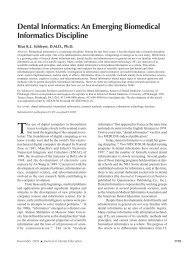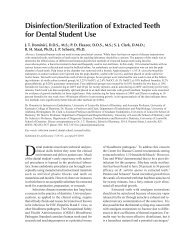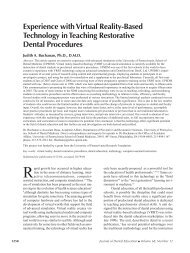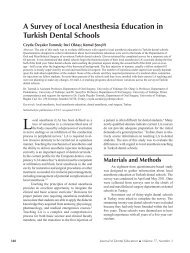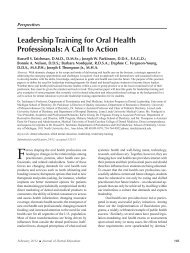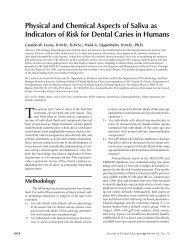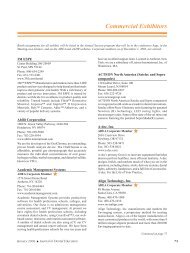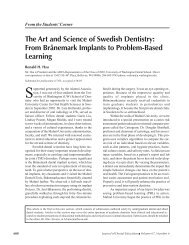List of Poster Presentations - Journal of Dental Education
List of Poster Presentations - Journal of Dental Education
List of Poster Presentations - Journal of Dental Education
Create successful ePaper yourself
Turn your PDF publications into a flip-book with our unique Google optimized e-Paper software.
<strong>Poster</strong> Abstracts<br />
Based on the strong correlation between the PAT and preclinical<br />
laboratory technique performance, dental schools may want to<br />
reconsider the weighting <strong>of</strong> admissions criteria.<br />
20. Handheld Device Technology: A Comparative<br />
Device Analysis to Support Oral Health Training<br />
Gray, Kale T., University <strong>of</strong> Louisville School <strong>of</strong> Dentistry, Williams,<br />
John N., University <strong>of</strong> Louisville School <strong>of</strong> Dentistry<br />
The characteristics <strong>of</strong> several commercially available Hand Held<br />
Devices (HHD) were compared to determine the most appropriate<br />
HHD for use as a portable multimedia training device.<br />
The characteristics <strong>of</strong> several commercially available Hand Held<br />
Devices (HHD) were compared to determine the most appropriate<br />
HHD for use as a portable multimedia training device. The<br />
comparative analysis was done as a subcomponent <strong>of</strong> a larger pilot<br />
study (HRSA Grant #6-U76PE-00238-09 Office <strong>of</strong> Technology) to<br />
test the use <strong>of</strong> a HHD as a means to train non-dental health<br />
pr<strong>of</strong>essionals in how to conduct an oral health screening to aid in the<br />
prevention, early detection, and appropriate referral <strong>of</strong> oral health<br />
conditions. The desirable HHD criteria included: 1) ability to present<br />
both text and high quality color images; 2) ability to support a webbased<br />
format, 3) ease <strong>of</strong> use, and 4) ease <strong>of</strong> technological support.<br />
The training was to be delivered in the form <strong>of</strong> a virtual oral health<br />
handbook using a familiar web-based format presented on the HHD.<br />
Five HHD representing the two dominant HHD operating systems<br />
were compared: 1) the Palm OSTM (Palm m505 TM , Handspring Visor<br />
Prism TM , and 2) Windows CE TM (Compaq Ipaq 3670 TM , Casio<br />
Cassiopeia E-125 TM , and HP Jornada 540 TM . Based on expert opinion,<br />
it was determined that three devices were capable <strong>of</strong> initially meeting<br />
all evaluation criteria (the Palm m505 TM , Handspring Visor Prism TM<br />
and Cassiopeia E-125 TM ). Upon further evaluation, the Windows CE<br />
TM TM HHD (Casio Cassiopeia E-125 ) showed superior attributes in<br />
achieving all criteria. In conclusion, current HHD technology exists<br />
to provide portable, interactive, multimedia training. The Casio<br />
Cassiopeia E-125 TM currently provides the best combination <strong>of</strong><br />
s<strong>of</strong>tware, resolution, and color depth for the accurate presentation <strong>of</strong><br />
text and high quality color images for portable multimedia training.<br />
Current HHD technology exists to provide portable, interactive,<br />
multimedia training. The Casio Cassiopeia E-125 TM currently provides<br />
the best combination <strong>of</strong> s<strong>of</strong>tware, resolution, and color depth for the<br />
accurate presentation <strong>of</strong> text and high quality color images for portable<br />
multimedia training.<br />
21. The Teaching <strong>of</strong> Class I and II Restorations in<br />
Primary Molars: A Survey <strong>of</strong> North American <strong>Dental</strong><br />
Schools<br />
Guelmann, Marcio, University <strong>of</strong> Florida College <strong>of</strong> Dentistry, Mjor,<br />
Ivar A., University <strong>of</strong> Florida College <strong>of</strong> Dentistry, Jerrell, Greg R.,<br />
University <strong>of</strong> Florida College <strong>of</strong> Dentistry<br />
The purpose <strong>of</strong> this study was to obtain an overview <strong>of</strong> materials<br />
and restoratives techniques taught for Class I and Class II restorations<br />
in primary molars in North America.<br />
Amalgam has been taught for decades as the material <strong>of</strong> choice<br />
for Class I and II restorations in primary molars. For the last twenty<br />
years, numerous clinical and laboratory studies using tooth-colored<br />
materials for posterior restorations in primary teeth have been<br />
published. New cavity designs have been suggested as well as new<br />
condensation and polymerization techniques. Information about the<br />
teaching <strong>of</strong> resin based composites on permanent teeth is available.<br />
The teaching status for restorations in primary teeth in North America<br />
has not been investigated. Methods: A form with response alternatives<br />
was mailed to all sixty-three dental schools in United States and<br />
Canada. Questions regarding the restorative materials taught,<br />
indications and contraindications for the use <strong>of</strong> tooth colored materials<br />
and the type <strong>of</strong> cavity preparation indicated for those materials were<br />
among the topics assessed. Results: Eighty-six percent <strong>of</strong> the dental<br />
schools responded to the survey. Amalgam continues to be the material<br />
<strong>of</strong> choice for Class I and II restorations in primary molars, although<br />
hybrid composites and compomers are gaining some popularity. When<br />
tooth colored materials were indicated, the slot type <strong>of</strong> cavity<br />
preparation was preferred.<br />
The diversity in teaching may reflect uncertainty related to<br />
requirements for optimal restorations <strong>of</strong> primary teeth. The data<br />
presented should be used to initiate discussions about standardization<br />
<strong>of</strong> the teaching and lead to research to provide an evidence base for<br />
restorations in primary teeth. Data from dental schools <strong>of</strong> other<br />
countries and from pediatric practices will be important to obtain, in<br />
order to establish universally accepted criteria and standards for<br />
optimal restorative techniques <strong>of</strong> primary teeth.<br />
22. A Comparison <strong>of</strong> Evacuation Devices on Aerosol<br />
Reduction for <strong>Dental</strong> Hygiene Practice<br />
Jacks, Mary E., University <strong>of</strong> Texas Health Science Center at San<br />
Antonio<br />
Purpose: To test an ergonomically sound and effective<br />
evacuation method for dental hygiene practice the thereby lending<br />
support to the recommendations from the ADA and the CDCP for<br />
high volume evacuation use during ultrasonic instrumentation.<br />
Aerosols, defined as airborne particles ranging in size from 10<br />
to .5 microns, are produced during ultrasonic instrumentation, and<br />
can be reduced. Irrigant solutions, which produce the healing effects<br />
<strong>of</strong> lavage, also combine with blood, saliva, and bacteria to produce<br />
potentially harmful airborne particulates. The American <strong>Dental</strong><br />
Association (ADA) and the Center for Disease Control and Prevention<br />
(CDCP) recommends utilization <strong>of</strong> high volume evacuation, rubber<br />
dam, and patient positioning for aerosol control; for the non-assisted<br />
dental hygienist these recommendations are difficult to manage. This<br />
study was designed to test an ergonomically sound and effective<br />
evacuation method for dental hygiene education.<br />
Methods: This laboratory study compared the concentration <strong>of</strong><br />
airborne particlates from ultrasonic scaling utilizing three different<br />
evacuation techniques: a standard intra-orally positioned saliva ejector;<br />
and two extra-orally positioned, hands-free high volume evacuation<br />
(HFHVE) techniques, (a) with a standard attachment and, (b) with a<br />
funnel shaped attachment. Particles were generated utilizing a 25,000<br />
cps magnetostrictive ultrasonic scaling instrument, and measured with<br />
a DataRAM Real-Time Aerosol Monitor.<br />
Results: Results <strong>of</strong> this study (N=21) found a significant<br />
reduction in the number <strong>of</strong> airborne particulates with either form <strong>of</strong><br />
HFHVE in place. Standard attachments and funnel shaped<br />
attachments to HFHVE resulted in reduction <strong>of</strong> particulates by 90.8%<br />
and 89.7% respectively. Therefore, utilizing either form <strong>of</strong> HFHVE<br />
during ultrasonic instrumentation significantly reduced the number<br />
<strong>of</strong> airborne particulates that reach the breathing space <strong>of</strong> the client<br />
and clinician.<br />
Utilizing either form <strong>of</strong> HFHVE during ultrasonic<br />
instrumentation significantly reduced the number <strong>of</strong> airborne<br />
particulates that reach the breathing space <strong>of</strong> the client and clinician.<br />
Currently, no preventive measure is 100% effective; therefore,<br />
clinicians are encouraged to use additional methods to minimize the<br />
effects <strong>of</strong> airborne particulates.<br />
23. Technological Advancements in <strong>Dental</strong> <strong>Education</strong><br />
Krajekian, Joseph I., Tufts University School <strong>of</strong> <strong>Dental</strong> Medicine,<br />
Zemnick, Candice, Tufts University School <strong>of</strong> <strong>Dental</strong> Medicine<br />
264 <strong>Journal</strong> <strong>of</strong> <strong>Dental</strong> <strong>Education</strong> ■ Volume 66, No. 2



